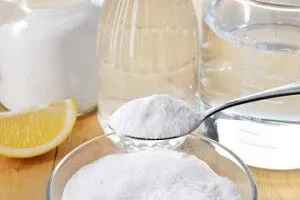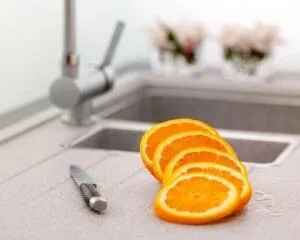No One Wants A Smelly Garbage Disposal!
What's That Smell?
You took out the trash, nothing in the refrigerator has spoiled and you haven't been cooking fish, but that foul smell in your kitchen persists. If this is the case, you may want to check the garbage disposal. Many people never think about cleaning the garbage disposal, but it can often be the cause of that mysterious odor.
While disposals are designed to be self-cleaning, food can sometimes become stuck in the grinders, allowing odor-causing bacteria to grow and reduce the disposal and drain efficiency. Here are five ways of deodorizing your garbage disposal and how to avoid having the smell come back:
Five Ways of Deodorizing
1) Remove Large Objects
Before beginning, disconnect the power to the disposal by unplugging the unit or turning off the breaker. Push the rubber drain guard aside and shine a flashlight into the disposal to see if any large matter, such as bone fragments, corn husks or fruit pits, have become stuck in the disposal. Rotate the grinder disk by hand while trying to remove the stuck food matter, using a pair of pliers, if necessary. Just be careful not to pull too hard on the grinder blade, or you could damage the disposal mechanism.
Reconnect the power, set the drain plug in place and fill the sink with water. Pull the plug and turn on the disposal and let it run while the water drains from the sink. This should clear the disposal of larger particles. If not, you may need to call a plumber. Once the disposal has been cleared of large particles you can deodorize the drain.
2) Use Natural Remedies
 There are several all-natural methods you can use to deodorize the disposal, without having to resort to caustic chemicals. Here are three tried-and-true methods:
There are several all-natural methods you can use to deodorize the disposal, without having to resort to caustic chemicals. Here are three tried-and-true methods:
- Ice, Salt and Vinegar: Drop three to four trays of ice cubes into the drain. Add a cup of vinegar and a cup of salt and turn the disposal on until all the ice has been ground up. The ice will freeze any stuck food particles, the salt will work as a mild abrasive, to scrub the grinder clean, and the vinegar adds a highly-acidic agent to kill bacteria. Run the disposal, with the water on, for two minutes after the last of the ice is gone.
- Baking Soda: Bicarbonate of soda, AKA baking soda, is a natural deodorizer that eliminates odors on contact. Just as it works to remove odors from the fridge, baking soda will also help to deodorize the disposal. Just pour 1/2 cup of baking soda down the drain and rinse with warm water.
- Baking Soda and Vinegar: For really nasty odors, pour 1/2 cup of baking soda into the disposal and add 1/2 cup vinegar. The chemical reaction will help to loosen any stuck-on bits of nastiness. Allow the reaction to work for 15 minutes and rinse with hot water.
- The Power of Citrus: The citric acid in oranges, lemons and limes are great for killing bacteria and can be used for deodorizing your garbage disposal by following these simple steps:
- Chop up citrus fruit into small 1/2-inch pieces.
- Turn on the water and disposal and feed the pieces of fruit into the disposal. Add the fruit slowly, so that the grinder's blades can more easily deal with the tough citrus peel.
Avoidable Objects
 It is helpful to understand how a disposal works in order to know what you shouldn't put down your drain. In theory, all garbage disposals are self-cleaning and will remain clean and odor free, if used correctly.
It is helpful to understand how a disposal works in order to know what you shouldn't put down your drain. In theory, all garbage disposals are self-cleaning and will remain clean and odor free, if used correctly.
All disposals work essentially the same, having an upper- and lower-hopper chamber. The upper chamber handles the food and the lower chamber deals with the slurry produced by the upper chamber, pushing it down the drain.
In a garbage disposal, the term “blades” is actually a misnomer, as there are no knives that chop up food. The upper hopper chamber holds a grinding, of impeller, plate with tabs, often referred to as “teeth.” The job of the teeth is to smash food up while forcing the resulting slurry down into the lower chamber. Once food is smashed up it simply collects in the bottom hopper until it drains out, helped along by the impeller teeth. This is why it is important to never put anything down the disposal that won’t either dissolve or break up. Tough and fibrous items, such as banana peels, or items that tend to clump up, like potato peels, should never be put down the drain. Here is a list of some items that should never be put into the garbage disposal:
- Fibrous foods, such as corn husks, rhubarb, celery stalks, artichokes, onion skins and asparagus.
- Grease or fat is a huge factor, resulting in clogged pipes and causing wretched odors.
- Fatty foods will congeal and will catch all sorts of other foods, making
- it much harder to clean and deodorize.
- Metal, glass, plastic, paper and cigarette butts.
- Foods that will expand, like dry rice or pasta.
- Large amounts of potato skins.
- Bones of any type.
- Egg shells, due to the sticky membranes on the inside of the shell.
- Coffee grounds, as the fine particles can become lodge under the disk, or in the trap, and will build up in your pipes.
- Gooey foods like fish, including shellfish like lobster and shrimp, and honey.
- Here are a few additional tips to keep your disposal odor free and running as it should:
- Always cut up large chunks of food into smaller pieces before running it through the disposal.
- Run 1/2 cup of baking soda down the disposal once a week to keep odors from building up.
- Never use drain cleaners, that are typically made up of fine sand and bleach, or caustics cleaners, as these will damage and drastically shorten the life if your disposal.
- Be sure you always run the garbage disposals for 30 seconds after the grinding stops to be sure all food is rinsed out of the upper chamber.
If you are in need of further assistance with your garbage disposal feel free to call C&D Plumbing Inc, in Fort Lauderdale, FL at (954) 758-8169.

